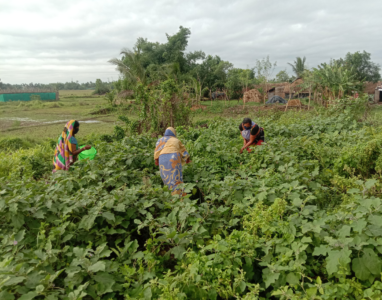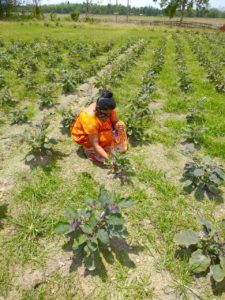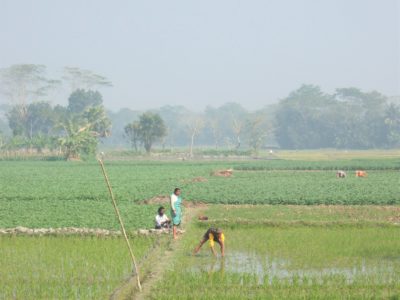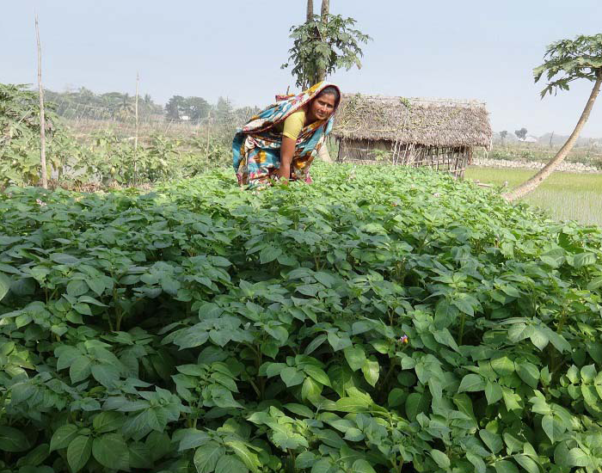While the world addresses the important short-term effects of COVID-19 on the human population, many scientists are turning their attention forward to anticipate and understand the long-term effects on the systems that support human society, such as agriculture.
At the International Potato Center (CIP), scientists have begun having conversations about the role of potato and sweetpotato in strengthening food systems globally. While the effects of COVID-19 are stark and immediate, longer-term concerns point to possible scenarios of food scarcity in developing countries.
To understand how COVID-19 is affecting food systems in Asia, we had a virtual sit-down with two CIP scientists: Samarendu Mohanty, the Regional Director for Asia, and Marcel Gatto, an agricultural economist. Both acknowledged the potential seriousness of food and labor shortages in 2020 and 2021, but they also see many opportunities for using the crisis to make interventions that foster long-term change for nutrition and food security. Moreover, Gatto and Mohanty say COVID presents an opportunity for deep reflection on the various health-related, socio-economic, and environmental implications of current food production modalities, so that after COVID, a “new normal” might be established.

They spoke with Managing Editor, Christopher Butler, about these issues and more.
Sam, you have said that agriculture, unlike other sectors of the economy, is affected more by timing than duration. Can you please explain why that is true?
Mohanty: Many agricultural crops – cereals, potatoes – are seasonal. Crops are planted and harvested at specific times. When governments talk about easing the restrictions imposed due to COVID-19, many sectors can be kickstarted at any time: textiles, IT, etc. But if your planting season is gone, it’s gone until next year. You are constrained by seasonality. You must be careful in terms of shutting down agriculture and re-starting. For instance, May is the harvesting season in southern India and the potato planting season in more temperate climates. So, if farming activities are under total lockdown, those harvests will be lost until next year.
Sam, you have written about the danger of imposing trade restrictions on food because they can lead to panic buying and sky-high prices, among other problems. Obviously, keeping trade flowing across borders is one solution. Imagine for a moment that I am a government official. Please give me two pieces of advice to guide our national agricultural sector.
Mohanty: Agriculture was protected until the early 1990s by the World Trade Organization (WTO). But since then we have seen global agricultural trade triple in value. It is now around USD 1.5 trillion annually. When you trade agricultural commodities, you get more stability in prices and more uniform distribution. So, if you decide to put the cap back on the bottle and stop international trade, domestic prices will rise. So, it is not effective policy to close borders. The best policy is to keep borders open so you can trade for the commodities your country needs the most at any point in time.
The conventional wisdom of closing trade borders to protect national produce does not apply in COVID. Countries should keep trade channels open to ensure stable prices and reliable supply.
That way prices will remain stable. But not if you close your borders. If government officials wish to protect food security in their countries, they will not be able to do so if they close its borders to trade. In the short term you can distribute some grains and other products that you are trying to protect, but in the long term you will again be exposed to the pricing and dynamics in the rest of the world. We have many examples of this policy failure in the past.
 So, I have been advising countries not to close their borders. I tell them don’t put restrictions on rice exports, which is a very price sensitive commodity. But we see already in Myanmar, Vietnam, and Cambodia… they have halted exports. This really is not a solution to our problem.
So, I have been advising countries not to close their borders. I tell them don’t put restrictions on rice exports, which is a very price sensitive commodity. But we see already in Myanmar, Vietnam, and Cambodia… they have halted exports. This really is not a solution to our problem.
The International Monetary Fund (IMF) has reported that due to COVID, they expect zero growth in Asia in 2020 – the first time this has happened in more than two decades. What role can large multilateral organizations (like the IMF), donors, and developed countries play in revitalizing food systems post-COVID?
Mohanty: All groups need to think about long-term reforms in our food systems. I think the worst thing we could do right now is create a series of temporary fixes. This is an opportunity to address long-term issues with our food systems. We have not had a global crisis like this in more than a century. So, we are facing unprecedented challenges to our food system, challenges for which we have no precedence. So, we need to use this as a learning moment and fix the systemic problems that we have not yet addressed, like climate change. It would be a mistake to only focus on the short-term now without having a wider and longer-term outlook.
For example, in India, they are using this opportunity to solve the land tenure policy. Land tenure has nothing to do right now with rice production and COVID-19. But I think if we address the land tenure policy in India, that will solve many problems in the future, such as reducing the number of landless people. We also need to improve our understanding of the larger social and policy forces shaping our food systems.
Marcel, what role does sustainable intensification have to play in restoring and rehabilitating food systems?
Gatto: Let me start by saying that there are many definitions of sustainable intensification. The most common ones are related to conservation agriculture, which means using farm management techniques with the aim to reduce the use of water, chemical fertilizer, and pesticides, while, at the same time, increasing yields.
Another definition is more about intensification of agriculture, for instance, by adding another crop into existing land, and in doing so, minimizing environmental degradation. Now, to understand the role of sustainable intensification in restoring and rehabilitating food systems, we need to first understand how the pandemic has affected food systems and, in particular, smallholder farmers.
Sustainable intensification of agriculture with potatoes is a promising avenue for farms wanting to boost their yields, however, recent restrictions on mobility could impede finding the required additional labor.
First, agricultural production may be disrupted by shortages in inputs, such as clean seed or quality vines, chemical fertilizer, etc. These inputs may become more costly and/or less available. Second, hired labor may not be readily available anymore due to restrictions on mobility within countries. Third, and related, the ability of farmers to travel to markets to buy inputs or to sell produce may be constrained.
Against this backdrop and the increasing restrictions on mobility, global and domestic value chains will be disrupted with likely consequences for rural incomes and food availability and, consequentially, food security.
 Now, sustainable intensification may play an important part in restoring and rehabilitating food systems, especially for smallholder farmers. Take the example of inputs which are either costly, limited in their availability, or both. If more farmers adopted conservation practices, they would be less dependent on the inputs and save money, which could be used elsewhere. This would also reduce the effects on the environment while maintaining or even increasing agricultural output. Of course, this is the ideal scenario and we know that in real life things do not play out so smoothly. Adoption rates of conservation practices often lag behind expectations. But maybe COVID-19 can incentivize farmers, even out of necessity, to adopt some sustainable farming practices. But to achieve this, governments need to increase investment in training and targeted awareness campaigns to accelerate the transfer agronomic know-how to smallholder farmers.
Now, sustainable intensification may play an important part in restoring and rehabilitating food systems, especially for smallholder farmers. Take the example of inputs which are either costly, limited in their availability, or both. If more farmers adopted conservation practices, they would be less dependent on the inputs and save money, which could be used elsewhere. This would also reduce the effects on the environment while maintaining or even increasing agricultural output. Of course, this is the ideal scenario and we know that in real life things do not play out so smoothly. Adoption rates of conservation practices often lag behind expectations. But maybe COVID-19 can incentivize farmers, even out of necessity, to adopt some sustainable farming practices. But to achieve this, governments need to increase investment in training and targeted awareness campaigns to accelerate the transfer agronomic know-how to smallholder farmers.
Let us consider another example. COVID-19 will inevitably affect food production and the availability of food. Here, sustainable intensification can contribute to increased food production by using the same area of land while minimizing the effects on the environment – through the practices I mentioned earlier. The potential of intensification with a crop that matures within a window of some 90 days is enormous. In a study we recently conducted, we found that some 6 million hectares of land in the eastern Indo-Gangetic Plains of west Bengal in India and Bangladesh are suitable for intensification. The total area in developing countries, globally, is much higher and if those acres were brought into agricultural production, for instance, by adding potato and sweetpotato, but also pulses and other crops, this could contribute to increased food production and thus alleviate the effects of COVID-19.
You have studied the trade-offs required for sustainable intensification of agriculture. How might the effects of COVID-19 on mobility influence those trade-offs compared to a business-as-usual scenario?
Gatto: As already pointed out, restrictions on mobility will have a significant effect on agriculture in general, but specifically on agriculture in the context of sustainable intensification.
The reason is that sustainable intensification already requires more labor compared to a business-as-usual scenario, or what I would call conventional agriculture. This is the case for many conservation and agricultural intensification practices because farmers actually add another crop into their cropping systems. These additional labor requirements are what we call a socio-economic tradeoff of producing more food.
Now, add the effects of COVID-19 into the mix: Millions of seasonal workers are restricted from moving and become vulnerable as their incomes from wage labor decrease. Households cannot hire seasonal labor anymore for their priority crops, which is rice in Asia, and must resort more often to family labor which means that the household itself must work harder to maintain the status quo. The production of other non-priority labor-intensive crops, such as potato, will likely be reduced in the short-term.
In addition, households will likely seek other sources of labor. Of course, as I mentioned, men and women will both have to work more to maintain agricultural production levels compared to a business-as-usual scenario. But, in addition, we will likely see a surge in child labor to support the household.
Despite the potential of sustainable intensification, increased labor requirements constitute a serious barrier to adoption for many smallholder farmers who are, currently, struggling with keeping the status quo.
To lessen the impact of COVID-19 on mobility restrictions and to increase food production generally, village communities will need to become increasingly self-sufficient and create networks to meet their own labor requirements. Farmers will need to support each other, and farmer and other organizations will other organizations may play a crucial part in this.
But also, COVID-19 may reveal some opportunities. For instance, many seasonal workers in urban and rural areas lost their jobs. What do people do? I expect many of those workers – many of whom are young – will return home to their villages and communities. Maybe they will be able to support farming and their families to produce food. This alleviated burden may give farmers space and time to consider adopting more sustainable practices. Clearly, COVID-19 presents an opportunity to attract young people to agriculture, more out of necessity than free will, but it is a start at least. A challenge will probably be how to keep them there.
COVID is exposing systemic problems with labor, land use, land tenure and food production in Asia. Governments and donor agencies would be wise to use this opportunity to examine how these underlying problems have magnified the effects of the COVID crisis.
Mohanty: Seasonal workers are also, usually, migrant workers in Asia, either from different regions of the same country or from neighboring countries. In Thailand, most migrant workers come from Cambodia and Myanmar. In northwestern India, the breadbasket of the country, the migrant workers generally come from the northern part of country. As Marcel mentioned, migrant workers have gone back to their village because they don’t have work. They need to be engaged in agriculture. For years, rural agriculture suffered from outward migration. For the first time in recent years, there is an inward migration, at least temporarily. The traditional breadbasket areas suffer from huge labor shortages and the less developed parts of the country will face surplus labor problems. If workers do not return after COVID, these breadbasket areas will suffer even more and governments need to plan on how to address this problem before it is too late.
Gatto: I agree. Governments need to make sure that enough labor stays in agriculture.
How will potato and sweetpotato be unique in the post-COVID scenario. I understand it is not a highly traded commodity. What does that mean for potato and sweetpotato production in the larger project of restoring food production?

Gatto: First, both potato and sweetpotato are important crops for million smallholder farmers around the world, both for home consumption and cash income. However, the importance of the crops varies from region to region, of course. But irrespective of whether they are traded a lot or only consumed at home, potato and sweetpotato are different in many ways compared with other crops.
First, both crops have relatively short cropping cycles, of about 100 days, which allows them to be cultivated in traditional rice-systems. For sweetpotato, in particular, there are some key advantages. For instance, little technical knowledge is required to cultivate the crop. It grows on poor soils, and in high drought and salinity-affected regions. And sweetpotato requires few inputs and grows underground like potato.
These traits make sweetpotato especially suitable in post-disaster situations providing an early response. We conducted a study in the Philippines in 2019, a couple of months after typhoon Ompong hit. We found that farmers who cultivated sweetpotato and other root and tuber crops had a clear yield advantage over other major above-ground crops, such as rice, maize, and wheat. We also found that farmers started growing sweetpotato within the first four weeks after the typhoon struck. They did so because of the traits I just mentioned, which contributed to food security in times of crisis. These findings suggest that sweetpotato is a great early-response crop, and we need to harness its strength to quickly restore food production in many countries.
Another advantage of both crops is that they are vegetatively propagated and the seed systems are characterized by a high degree of informality with little to almost no existing private sector engagement. This informality in times of COVID-19 is a clear advantage compared to major cereal crops with high degree of formality. Potato and sweetpotato planting material can thus be produced and shared within village communities. These informal networks need to be leveraged to allow farmers to access inputs, technical knowledge, price information, etc. for various other crops which are produced more in the formal domain.
In sum, both potato and sweetpotato hold great potential to contribute to food security and restore localized food production, where possible, in a sustainable manner.
Mohanty: If we look at consumption patterns of potato and sweetpotato, they used to be grown and consumed fresh at home – boiled or cooked. But now in the West we see almost 80% of potatoes are processed, such as chips and fries. The consumption of fresh potato has gone way down in the West. But now with COVID, restaurants have closed and there’s no demand for processing potatoes right now. People are now seeking fresh potato to cope with the crisis but there’s not enough available right now. You can’t substitute for fresh potato. People do not want to bring home a half-kilogram of large processing potatoes. They prefer mid-size because they are easier to cook for families and taste better.
But this is taking place mostly in highly industrialized nations. So why do I mention it? Because this is an opportunity for people to (re)introduce potato and sweetpotato into their diets as unprocessed foods tend to be more nutritious. Sweetpotato is a super food, or future food, if you like. Eating baked or grilled sweetpotato is so much better for your health than chips or fries. COVID-19 is teaching us a lesson to go back to eating fresh food.
This is the first in a series of roundtable interviews with CIP scientists to collect their thoughts about the impact of COVID and how food systems can be sustained and strengthened in the long term. In the coming days, we will feature more discussions from CIP people working in Africa and Latin America.
